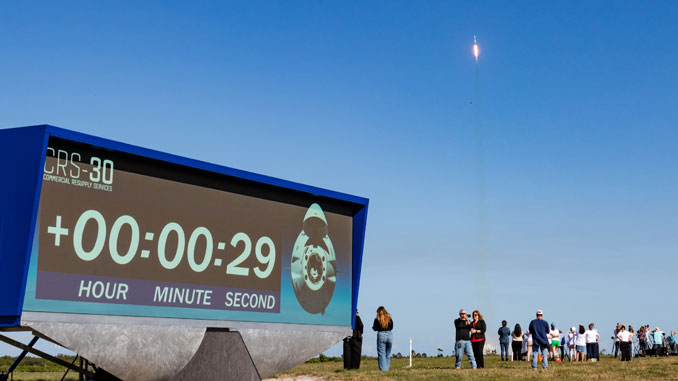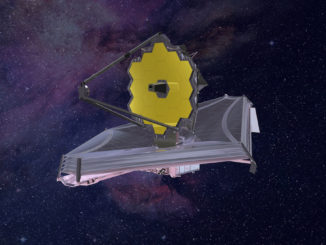
Update: Liftoff occurred on time at 4:55 p.m. EDT and was followed by separation of the Cargo Dragon vehicle a little less than 12 minutes into flight.
SpaceX kicked off the next phase of launches from Cape Canaveral that was, in a way, a callback to a previous era in their launch history. Thursday’s Falcon 9 launch marked SpaceX’s 30th flight as part of NASA’s Commercial Resupply Services (CRS) program, but it was also the first time a Dragon 2 spacecraft launched to the International Space Station (ISS) from pad 40.
Liftoff of the Falcon 9 rocket and Cargo Dragon spacecraft on this mission happened at Thursday, March 21, at 4:55 p.m. ET (2055 UTC). More than 6,000 pounds of cargo and science was packed into the capsule, which will dock autonomously to the zenith port of the ISS’ Harmony module on Saturday morning at roughly 7:30 a.m. ET (1130 UTC). NASA astronauts Loral O’Hara and Michael Barratt, will oversee the docking process from inside the ISS.
The 45th Weather Squadron forecast conditions to be 90 percent favorable at liftoff on Thursday, with upper-level winds potentially being a limiting factor.
“The SpaceX 30 cargo vehicle is packed full of the hardware and samples to support a very diverse set of new and continuing research from all across the international partnership,” said Heidi Harris, the associated program scientist for NASA’s International Space Station Program Research Office.
“These investigations are taking full advantage of all of the things that the ISS has to offer, including exposure to the harsh environment of space, a unique vantage point in low Earth orbit and also a prolonged access to that microgravity environment where researchers can quite literally take gravity out of the equation to understand their science at a more fundamental level.”
During her remarks as part of a pre-launch teleconference, Sarah Walker, SpaceX’s director of Dragon Mission Management, said that she and the team are especially excited about where their Dragon 2 spacecraft will be launching.
“CRS-20, that last mission to launch off of 40, was the last in a long and successful initial cargo resupply contract with NASA using our first iteration Dragon vehicle,” Walker said. “And as you’re probably aware, it laid the groundwork for a follow-on contract for another 15 cargo missions and counting.”
The return of Dragon flights to pad 40 was made possible thanks to the construction and certification of a crew access tower that has been going through construction and checkouts for more than a year. Some of the final pieces that came into place were the addition of the crew access arm, which was added in November 2023, and the emergency egress system, which was tested in late February and early March of 2024.
There was some thought that the first crewed launch using the new tower would be the third private astronaut mission to the ISS in conduction with Axiom Space (Ax-3), but that didn’t bear out.
Walker noted that she personally has been with SpaceX’s Cargo and Crew Program since 2011, a year before SpaceX’s first Dragon flight to the ISS. She said it was wonderful to see Dragon flights return to pad 40 after a more than four-year hiatus.
“On many of the early CRS flights in the years that followed [the first launch]… I was loading cargo into Dragon right here on pad 40,” Walker said. “It was incredibly nostalgic for me to see the rocket and spacecraft roll to the pad on those old stomping grounds early [Tuesday] morning.”
“Back then, we loaded cargo while the vehicle was still horizontal using a mobile cleanroom before we would take the vehicle vertical for launch,” she added. “But thanks to this new, state-of-the-art crew tower, required for our human spaceflight missions, that late load cargo operation got a massive upgrade too.”
Robots, biology and coffee
The new cache of science heading up to the ISS will support a busy schedule for the members of Expedition 70 mission, soon to become Expedition 71. The Crew-8 astronauts recently arrived at the space station and will conduct about 200 experiments during their six-month stay at the orbiting outpost.
One of the highlighted experiments heading up to low Earth orbit is known as the Multi-resolution Scanner (MRS) payload, a new addition to the Astrobee free-flying robot currently on station. The experiment, performed in coordination with Boeing and Australia’s national science agency, CSIRO, will test the creation of 3D maps within the ISS. It’s also one of several experiments being sponsored in part by the ISS National Lab.
“This team has big plans for future applications in spaceflight. If it works well inside the ISS, this technology could be developed to use for scanning of exterior hull damage on the ISS or other space stations as well as lunar and martian surface scanning,” Parris said.

The CRS-30 flight continues the extensive research into plant biology in microgravity. Another experiment flying to the ISS is called C4 Photosynthesis in Space (APEX-09). It’s described as a system of using two types of grasses, C3 and C4, to help remove carbon dioxide from the atmosphere and add oxygen.
“Plants respond to stressful conditions based on their genetic makeup and the environment,” said Pubudu Handakumbura, principal investigator with the Pacific Northwest National Laboratory, in a statement. “We aim to uncover the molecular changes involved in plants exposed to spaceflight stressors and develop an understanding of the mechanisms of photosynthesis in space.”

There are also many other experiments flying, including research involving cellular and microbiology; crystal growth, astrophysics human research and material science, Parris said. She said there is also plenty of fresh food and other goodies heading up to the astronauts.
“A fresh food kit contains some citrus, apples, and cherry tomatoes. They have two coffee kits, which I think I would be probably be the most excited about,” said Kristi Duplichen, the deputy manager of NASA’s International Space Station Transportation Integration Office. “The crew requested those, so we’re making sure that we get them some fresh coffee.”
Some of the more temperature-sensitive foods and experiments were loaded as late as possible, which for a Cargo Dragon mission is about 24 hours prior to the planned liftoff, according to Walker.
Busy launch day
The CRS-30 mission was just one of four rockets scheduled to launch around the globe on Thursday and in fact. It was also not the only mission intending to head up to the space station.
At 1:27 a.m. ET (0527 UTC), the China Aerospace Science and Technology Corporation (CASC) launched the second batch of Yunhai-2 military weather satellites on a Long March 2D/YT-3 rocket.
That was followed at 3:25 a.m. ET (0725 UTC), Rocket Lab launched its fourth mission to date from Launch Complex 2 at Virginia Spaceport Authority’s Mid-Atlantic Regional Spaceport (MARS), which is located within NASA Wallops Flight Facility. The mission, called ‘Live & Fly’ or NROL-123, carried a classified payload to orbit on behalf of the National Reconnaissance Office.

That mission was supposed to be followed by the launch of the crewed Soyuz MS-25 flight to the space station with three passengers onboard, including NASA astronaut Tracy C. Dyson, who will be making her third trip to space. Liftoff from the Baikanor Cosmodrome scrubbed 20 seconds before T-0 at 9:21 a.m. ET (1321 UTC).
The Soyuz is now set to launch on Saturday morning and will dock with the Russian segment of the ISS on Monday. Once aboard the station, Expedition 71 will officially begin. That spacecraft will remain docked with the station for about six months, with a return anticipated in September.
“We are very busy and excited to have an extra crew on board. And then in May, we are looking forward to the launch of the first crewed Boeing test flight as well,” Duplichen said. “So, it is a very busy and exciting spring.”
Back at Cape Canaveral
The Falcon 9 first stage booster supporting the CRS-30 mission, tail number B1080 in the SpaceX fleet, launched for a sixth time on this flight. It previously supported the Ax-2 and Ax-3 missions for Axiom Space as well as launching the European Space Agency’s (ESA) Euclid telescope and two Starlink satellite missions.
As part of the Ax-2 mission, B1080 became the first booster to return for a land landing following a Crew Dragon launch. Similarly, about eight minutes after liftoff, B1080 touched down at Landing Zone 1 (LZ-1) at Cape Canaveral Space Force Station.
The Cargo Dragon spacecraft flying the CRS-30 mission, tail number C209, is making its fourth journey to the ISS. It previously clew the CRS-22, CRS-24 and CRS-27 missions.




